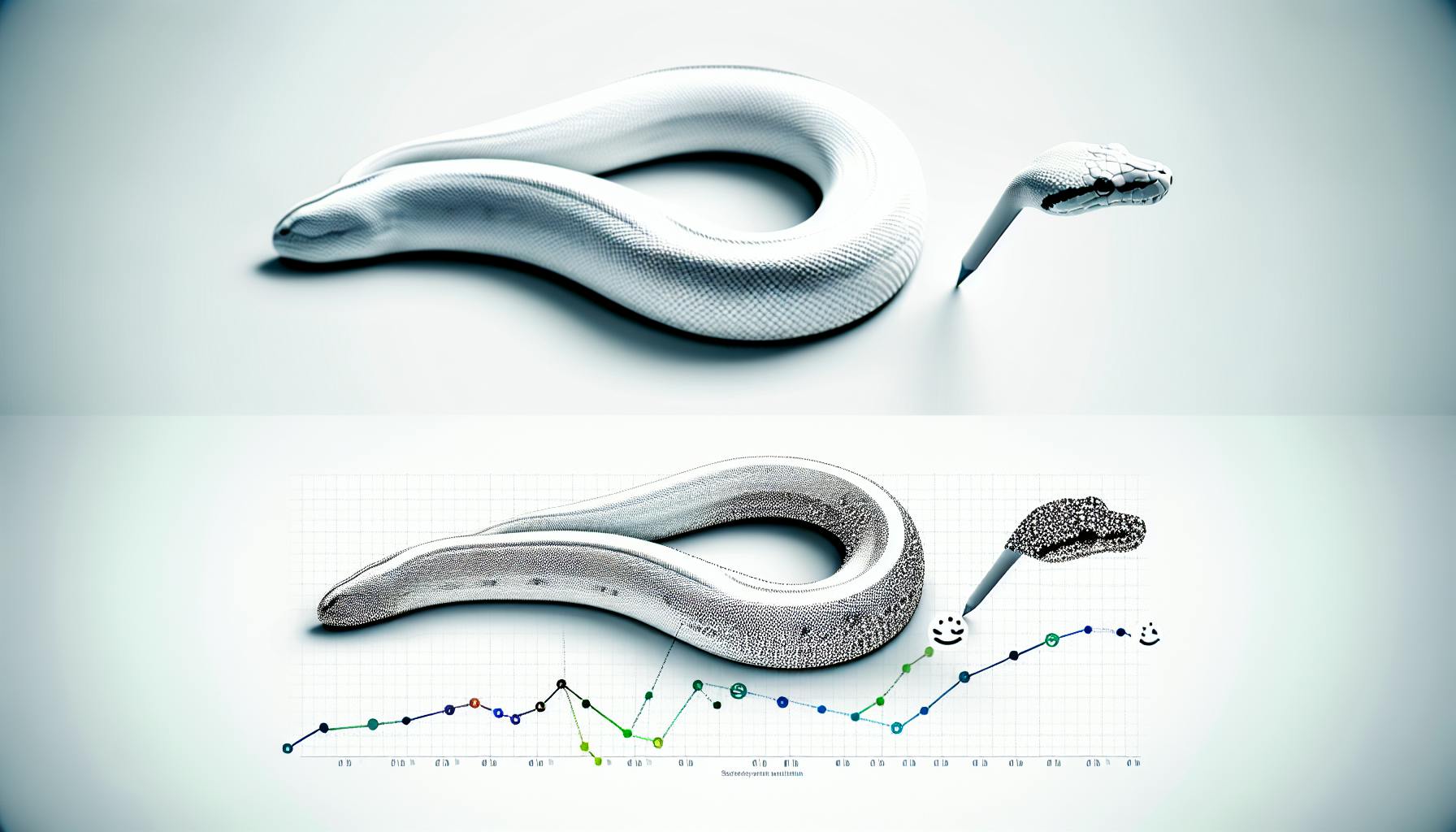Developing accurate machine learning models often feels like trying to find a needle in a haystack.
Luckily, ensemble algorithms like gradient boosting and AdaBoost make the process far more manageable.
In this post, we'll compare these two popular boosting techniques to help you determine which is best for your modeling needs.
Introduction to Boosting Techniques in Machine Learning
Boosting is an ensemble machine learning technique that combines multiple weak or "simple" models to produce a strong predictive model. Two popular boosting algorithms are gradient boosting and AdaBoost.
Gradient boosting produces a prediction model in the form of an ensemble of weak prediction models, typically decision trees. It builds the ensemble in a stage-wise fashion like other boosting methods do, but it generalizes them by allowing optimization of an arbitrary differentiable loss function.
AdaBoost, short for Adaptive Boosting, is also a boosting technique that combines multiple weak classifiers into a strong one. The key difference is that AdaBoost focuses on training instances that are hard to classify by assigning them higher weights.
Both gradient boosting and AdaBoost are useful for solving regression and classification predictive modeling problems in data science and machine learning. They can build robust models out of simple components, avoid overfitting, and perform regularization.
Understanding Gradient Boosting in Predictive Modeling
Gradient boosting builds an ensemble model by iteratively adding weak models, typically decision trees. It focuses on minimizing a loss function, like mean squared error for regression or log loss for classification. Each tree learns and improves upon the residuals or errors of prior trees. There are popular gradient boosting frameworks like XGBoost, LightGBM, and CatBoost.
Gradient boosting performs regularization naturally by constraining model complexity via early stopping, shrinkage, tree depth, and more. This avoids overfitting and improves generalizability. Overall, gradient boosting produces robust and accurate predictive models.
Deciphering AdaBoost in Supervised Learning
AdaBoost focuses on "hard" instances in the training data - those with high error that are difficult to fit. The algorithm assigns higher weights to these hard instances when training subsequent weak learners. Easy instances get lower weights.
This adaptive adjustment of instance weights allows AdaBoost to concentrate model capacity on hard training examples. AdaBoost is thus very sensitive to noisy data and outliers since it fixates on hard instances.
Overall, AdaBoost performs very well on clean data sets and can achieve great results by directing attention to the most informative training instances.
Similarities Between the Boosting Algorithms
Both gradient boosting and AdaBoost are ensemble techniques that combine weak learners like decision trees into strong predictive models. They build the ensemble in a stage-wise fashion, leveraging the wisdom of crowds.
They can effectively solve regression and classification problems in supervised machine learning. Both algorithms perform regularization to avoid overfitting, employ early stopping methods, and can handle missing data.
Distinguishing Features of Gradient Boosting vs AdaBoost
The most significant difference is that gradient boosting minimizes a loss function like MSE or log loss while AdaBoost focuses on instances with high error by adjusting their sample weights adaptively.
Gradient boosting models apply shrinkage to avoid overfitting which AdaBoost does not do. Gradient boosting also performs subsampling of the training instances while AdaBoost uses all instances to train every weak learner.
Overall gradient boosting is more robust to outliers and noise since it equally considers all training instances when optimizing the loss function. AdaBoost is faster but more impacted by dirty data since it fixates on hard examples.
Which is better gradient boosting or AdaBoost?
Gradient boosting and AdaBoost are both powerful ensemble machine learning algorithms based on boosting techniques. When comparing their performance, gradient boosting generally achieves higher accuracy.
Why Gradient Boosting Tends to Outperform AdaBoost
There are a few key reasons why gradient boosting often surpasses AdaBoost in predictive accuracy:
-
Gradient boosting is more robust and flexible. It allows fine-tuning many hyperparameters like learning rate, tree depth, etc. to control overfitting. AdaBoost has fewer tuning parameters.
-
Gradient boosting minimizes loss function. It adds new models to minimize the loss function of the whole ensemble. AdaBoost focuses on mislabeled examples.
-
Gradient boosting handles outliers better. It is less influenced by anomalies and noise in the training data.
-
Gradient boosting models complex data relationships better. It builds models sequentially and can capture complex data patterns that AdaBoost may miss.
So in most cases, carefully tuned gradient boosting models achieve higher accuracy. However, AdaBoost also has some advantages like being faster and simpler to train. So consider both algorithms for your use case.
When to Choose AdaBoost Over Gradient Boosting
There are some cases where AdaBoost may be preferred:
- When training time is critical. AdaBoost is faster to train.
- For simple linear decision boundaries. AdaBoost can perform well enough.
- If overfitting needs to be strictly controlled. AdaBoost is harder to overfit.
So AdaBoost can still be a good choice for some applications, but gradient boosting should be the first algorithm you try for most problems.
What is the difference between boosting and AdaBoost?
Boosting and AdaBoost are both ensemble machine learning techniques that combine multiple weak learners into a strong predictor. The key differences are:
-
Boosting is a general method that iteratively trains models to focus more on instances that previous models misclassified. Many boosting algorithms exist like Gradient Boosting, XGBoost, LightGBM, CatBoost, etc.
-
AdaBoost was the first successful boosting technique developed specifically for binary classification problems. It assigns weights to training instances, focusing subsequent models more on misclassified instances from previous iterations.
In both cases, models are added sequentially until a stopping condition is met. The key advantage is reducing bias and variance to improve predictive performance.
So in summary:
- Boosting is a general approach while AdaBoost is a specific implementation of boosting.
- AdaBoost is constrained to binary classification while boosting algorithms can handle both classification and regression problems.
- Boosting can use any base learner model like decision trees while AdaBoost relies specifically on decision tree classifiers.
The model comparison depends on factors like the problem type, evaluation metrics, data characteristics, and implementation efficiency. For tabular data, LightGBM and CatBoost tend to perform well while XGBoost is preferred for sparse features.
What is the difference between RF and AdaBoost?
Random Forests (RF) and AdaBoost are both ensemble machine learning algorithms that combine multiple weak learners into a strong predictor. The key differences are:
-
Training Method: RF trains each decision tree independently in parallel, while AdaBoost trains trees sequentially where each new tree attempts to correct errors from the previous one.
-
Tree Correlation: Trees in RF have low correlation as they use random subsets of features and data. AdaBoost trees are highly correlated as each focuses on misclassified instances.
-
Performance: RF generally has better accuracy by reducing variance. AdaBoost reduces bias but can overfit if run for too many iterations.
-
Hyperparameters: RF has simpler tuning of the number of trees and tree depth. AdaBoost also adjusts the learning rate and number of iterations.
-
Classification: RF performs internal cross-validation to estimate error when growing trees. AdaBoost uses explicit weights on training instances.
-
Implementation: RF is easier to understand and implement. AdaBoost is more complex methodologically.
In summary, RF is preferred when model interpretability is important. AdaBoost can produce compact ensembles but needs more careful tuning. For many problems, RF offers the best out-of-the-box performance, while AdaBoost is more sensitive to hyperparameters.
Is XGBoost better than gradient boosting?
XGBoost is an optimized implementation of gradient boosting that uses more advanced regularization techniques like L1 and L2 regularization. This helps prevent overfitting and improves the model's generalization capabilities.
Some key advantages XGBoost has over basic gradient boosting include:
-
Faster processing speed: XGBoost implements parallel processing and hardware optimization for faster model training. This allows it to handle very large datasets efficiently.
-
Higher predictive accuracy: The advanced regularization and other optimizations in XGBoost lead to higher predictive accuracy on many problems.
-
Controls overfitting better: The L1 and L2 regularization help prevent overfitting, allowing the models to generalize better to new data.
-
Supports various languages: XGBoost supports R, Python, Java, Scala, Julia, etc. making it easy to integrate into different tech stacks.
-
Actively maintained and improved: XGBoost has an active open source community continuously improving and adding new features to the library.
So in most cases, XGBoost does perform better than vanilla gradient boosting implementations. The additional optimizations make a significant difference in model training times, predictive accuracy, and overfitting control.
However, both algorithms have their own pros and cons. So the choice depends on the specific use case, data properties, and infrastructure available. But XGBoost is generally recommended over plain gradient boosting due to its additional capabilities.
sbb-itb-ceaa4ed
In-Depth Algorithmic Analysis
Gradient Boosting Mechanism and Decision Tree Improvement
Gradient boosting is an ensemble machine learning technique that produces a prediction model in the form of an ensemble of weak prediction models, typically decision trees. It builds the model in a stage-wise fashion, iteratively learning from the errors of previous models.
Here are some key aspects of how gradient boosting works:
- Starts with an initial model, usually small decision tree or constant value. This model gives baseline performance.
- Calculates the loss function (like MSE, LogLoss etc) to quantify the error in model predictions.
- Fits a new decision tree to predict the residuals or errors of the previous model. This new tree tries to minimize the loss function.
- The new tree is added to ensemble to update the model.
- The updated model makes better predictions as it learns from previous mistakes.
- The process is repeated, with new trees fit on residual errors until model stops improving.
So in summary, gradient boosting learns from errors, gradually improving the model by stacking trees that specialize in hard examples. This technique effectively combines multiple weak learners into a strong predictor.
AdaBoost Mechanism and Instance Weighting
AdaBoost, short for Adaptive Boosting, is also an ensemble method that combines multiple weak learners into a strong classifier. Here are some key aspects:
- Starts with an initial model, usually a simple decision tree stump. All training instances evenly weighted.
- Fit a new weak learner on updated weights, focusing more on previously misclassified instances.
- Instances that were incorrectly classified get higher weight, forcing model to focus on hard examples.
- The new weak learner is added to the ensemble and a weighting coefficient is calculated based on its accuracy.
- The process repeats, adapting to errors and reweighting instances.
- Final prediction is weighted majority vote of all weak learners.
So in summary, AdaBoost forces consecutive models to learn from mistakes of previous ones through clever instance weighting, allowing specialization in hard examples. The combined model is robust overall.
Model Comparison Using Performance Metrics
Comparing Accuracy Metrics in Ensemble Learning
Gradient boosting and AdaBoost are both ensemble learning techniques that combine multiple weak learners into a strong predictor. Key accuracy metrics to compare include:
-
Testing accuracy: Gradient boosting tends to achieve higher testing accuracy than AdaBoost. For example, XGBoost can achieve over 95% accuracy on some datasets compared to ~85% for AdaBoost.
-
F1 score: Gradient boosting also tends to achieve higher F1 scores, indicating a better balance of precision and recall. For certain applications, optimizing the F1 score is preferred over raw accuracy.
-
ROC AUC: The ROC AUC metric measures the model's ability to distinguish classes. Gradient boosting algorithms like XGBoost tend to achieve ROC AUC scores in the high 0.90s compared to 0.80s for AdaBoost models.
Overall, gradient boosting demonstrates superior predictive accuracy over AdaBoost, especially with recent innovations like XGBoost. However, both achieve reasonably good performance on most problems.
Analyzing Execution Time for Model Efficiency
In terms of computational efficiency:
-
Training time: AdaBoost is generally faster to train than gradient boosting methods. It builds models sequentially while gradient boosting must compute gradients from all previous iterations.
-
Prediction time: Prediction is very fast for both algorithms. They make predictions by summing the outputs from individual weak learners. The depth of the model impacts prediction speed, but gradient boosting and AdaBoost are quite fast in testing.
So AdaBoost holds some advantage in training efficiency over gradient boosting techniques. However, the higher accuracy of gradient boosting makes slightly longer training times worthwhile for most applications.
Evaluating Model Interpretability in Data Science
Model interpretability refers to how easy it is to explain why the model makes certain predictions.
-
AdaBoost is considered more interpretable since it uses simple base models like decision trees that are easier to analyze.
-
Gradient boosting can suffer from poor interpretability due to its complex model structure. However, techniques like SHAP values help explain individual predictions.
So AdaBoost provides more inherent model interpretability over complex gradient boosting models. But gradient boosting interpretability is improving with new tools. And its accuracy often outweighs interpretability concerns for business objectives.
Optimal Use Cases for Gradient Boosting and AdaBoost
Gradient boosting algorithms like XGBoost, LightGBM, and CatBoost tend to perform very well for regression and high dimensional problems. The technique is based on building an ensemble of weak prediction models, typically decision trees, in a stage-wise fashion. By iteratively focusing on misclassified examples, the ensemble minimizes loss and improves predictive accuracy.
Gradient Boosting: Ideal Scenarios and Data Types
Gradient boosting excels in modeling complex nonlinear relationships and interactions between variables. It performs well when:
- The dataset contains both categorical and continuous features
- There is a large number of features/predictors
- The data has missing values or outliers that need robust handling
- A nonlinear relationship exists between predictors and target
It can model numerical, binary, and multiclass target variables effectively. Due to its ensemble approach, gradient boosting generalizes well and avoids overfitting complex patterns.
AdaBoost: When to Use in Noisy Data Environments
AdaBoost, short for Adaptive Boosting, shines when working with noisy datasets and classification tasks. Its adaptive reweighting of examples helps improve predictions on difficult cases during training. Key advantages:
- Handles outliers and label noise robustly
- Reduces bias and variance compared to a single model
- Works well for binary and multiclass classification
- Computationally fast and simple to tune
AdaBoost is a great choice when the training data contains mislabeled examples or irregularities. By focusing on hard cases, it can correct errors and achieve high predictive accuracy.
Advanced Topics: XGBoost, LightGBM, and CatBoost
XGBoost: Extending Gradient Boosting Capabilities
XGBoost is an optimized distributed gradient boosting library designed to be highly efficient, flexible, and portable. It builds upon the basic gradient boosting algorithm and introduces several enhancements:
- Faster training speed and higher efficiency through algorithmic optimizations and parallel tree boosting
- Advanced regularization techniques like L1 and L2 regularization to prevent overfitting
- Support for handling sparse data and weighted samples natively
- Cache optimization with block structure for out-of-core computing
- Cross-validation and early stopping to find the optimal number of boosting iterations
These capabilities allow XGBoost to scale beyond the limitations of basic gradient boosting implementations. It can efficiently process larger datasets with fewer resources while achieving state-of-the-art results.
LightGBM: Efficiency and Scalability in Boosting
LightGBM is another gradient boosting framework focused on high performance and scalability. Some of its advantages include:
- Faster training speed and lower memory usage than XGBoost through the use of leaf-wise tree growth algorithms and histogram-based algorithms
- Advanced Gradient-based One-Side Sampling (GOSS) technique to filter out instances for faster processing
- Support for large-scale datasets with billions of samples through vertical and horizontal data partitioning
- GPU support for even faster training performance
- Highly optimized C++ implementation for efficiency
These capabilities make LightGBM well-suited for big data applications where efficiency and scalability are critical. It can train complex models on massive datasets with lower hardware requirements compared to other boosting libraries.
CatBoost: Handling Categorical Data with Boosting
CatBoost specializes in processing categorical features, which are very common in real-world datasets. Key capabilities include:
- Automatic processing of categorical data without needing one-hot encoding
- Utilizing a permutation-driven alternative to gradient descent for categorical feature optimization
- Support for categorical feature interactions without manual feature engineering
- Robust handling of categorical data with many values or categories
- GPU and multi-GPU support for faster training
By directly incorporating categorical data, CatBoost removes the need for extensive data preprocessing. This makes model training simpler while still achieving strong predictive accuracy.
Conclusion: Selecting the Right Boosting Algorithm
Final Thoughts on Gradient Boosting vs AdaBoost
Both Gradient Boosting and AdaBoost are powerful ensemble learning algorithms for building predictive models. However, they have some key differences:
-
Model Flexibility: Gradient Boosting is more flexible and can be used with different weak learners like decision trees. AdaBoost is restricted to decision tree models.
-
Overfitting Handling: Gradient Boosting has inbuilt regularization to prevent overfitting. AdaBoost can overfit if run for too many iterations.
-
Performance: Gradient Boosting typically achieves better accuracy by reducing bias and variance. AdaBoost is faster and simpler to tune.
So in summary:
-
Use Gradient Boosting when model performance is critical. It works well for complex data with higher dimensionality.
-
Choose AdaBoost when speed and simplicity are important. It can be a good baseline model before trying more advanced techniques.
The choice also depends on the problem type and size of the dataset. For smaller data, AdaBoost may be sufficient, while Gradient Boosting is preferable for larger, complex datasets.
Monitoring validation metrics like overfitting rate and cross-validation scores can indicate which algorithm is better suited. The key is experimenting with both to determine the right boosting technique for your problem.


